The contents of this article include a study of SEO platforms' keyword data in the US region ran by Semrush in Q4-Q1 2021-2022
As a marketer, your success depends highly on the quality of the data you use to make decisions.
At Semrush, it’s our job to give you the highest quality data we can provide.
So, a little over a year ago we set ourselves a goal. We wanted to focus on our search volume metric and significantly boost its reliability, making it as accurate as possible.
After a year of listening to your feedback, putting in the hard work, and assembling a team of 20 data scientists, we’re proud to say that we’ve finally hit our goal.
As of today, the update is fully rolled out to the databases for the US, UK, Australia, Canada, France, Spain, Italy, Belgium, Netherlands, Germany, Israel, and Brazil.
The study conducted by us in Q4-Q1 2021-2022 shows that at this time, the Semrush US database:
- Provides the most accurate Search Volume when compared to other industry-known tools on the market
- Grew its total number of keywords in the US database by 19%
- Can find data on nearly 98% of all actively searched keywords on Google in the US
What does a better search volume mean for you? A lot.
It means you can have more confidence than ever in your SEO plans. Your traffic forecasts will be more on-point and you can make razor-sharp predictions based on the volume of keywords, questions, and topics in your market.
More accurate data = more confident marketing decisions.
Want to know how we did it, and how we know it’s more accurate than any other tool?
Read on!
Search Volume Comparison Study
To test our search volume accuracy, we ran a competitive study between our keyword data and the data of top industry-known SEO platforms on the market using keyword data in the US region.
The competing platforms in the study were:
- Google Keyword Planner
- Semrush
- Moz
- Mangools
- Ahrefs
- Serpstat
- Sistrix
To judge the accuracy, the “true” search volume reference value was established based on anonymized Google Search Console data.
To find the true volume for each keyword, we collected the number of impressions received by URLs that were immediately visible on the keyword’s search results page. Using this method, we can say that, in most cases, X number of impressions = X number of searches for that keyword.
The study consisted of 2 stages: a comparison of volume quality (accuracy) and database coverage.
View the study’s methodology and parameters here.
Part 1. Volume Quality
First, we compared all seven tools at once. For each keyword in our sample of 10,000, we named the winner based on the platform whose value was closest to the reference value from GSC. From these comparisons, Semrush was most frequently the winner.
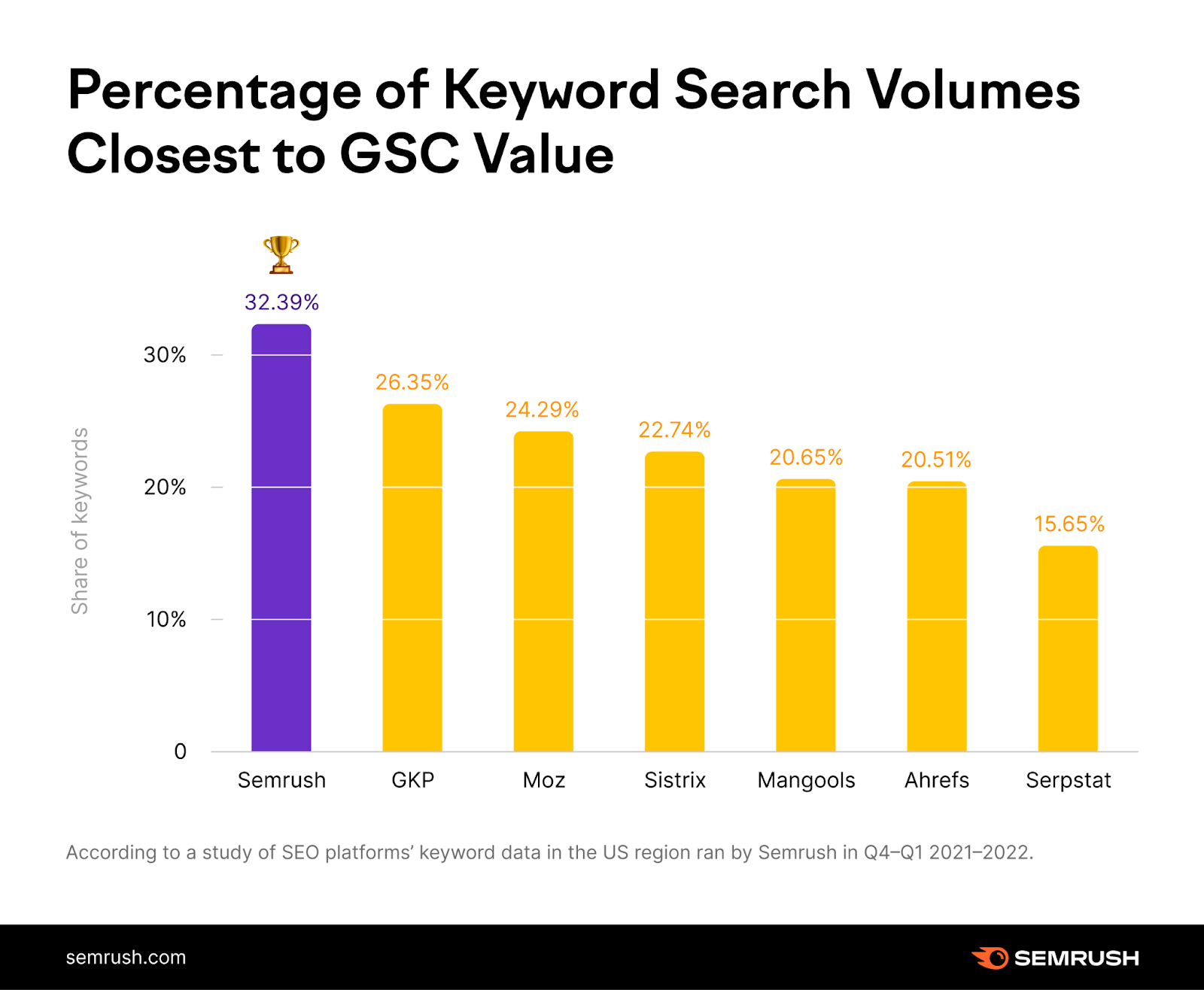
The sum of all results is not equal to 100%, because there were situations where several tools showed the same search volume. In those cases, all tools were considered winners.
Semrush had the highest percentage of keyword search volumes that were closest to GSC value (the higher the better).
Then, we also ran a series of head-to-head comparisons to evaluate how our search volume compared to each platform one-on-one.
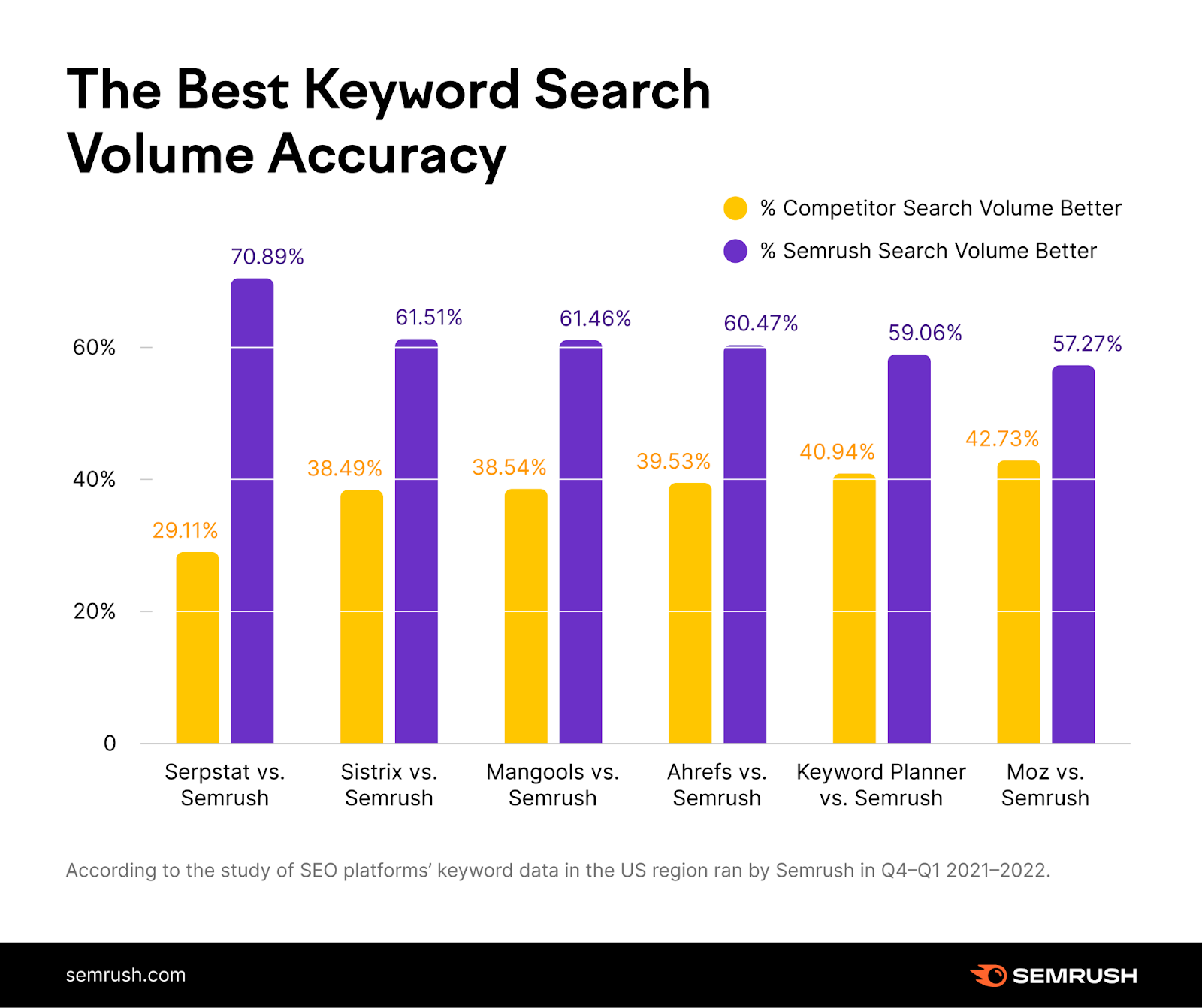
In all cases, Semrush won these head-to-heads by a large margin.
Trending Keywords Accuracy
As we dug deeper into the data, we found a few reasons why other tools performed so much worse than Semrush. One reason was inaccurate volume for trending keywords.
Trending keywords are being searched for the first time due to current events, or in seasonal waves. News, sports, and entertainment are common categories where you'd see trending keywords.
Here’s a breakdown:
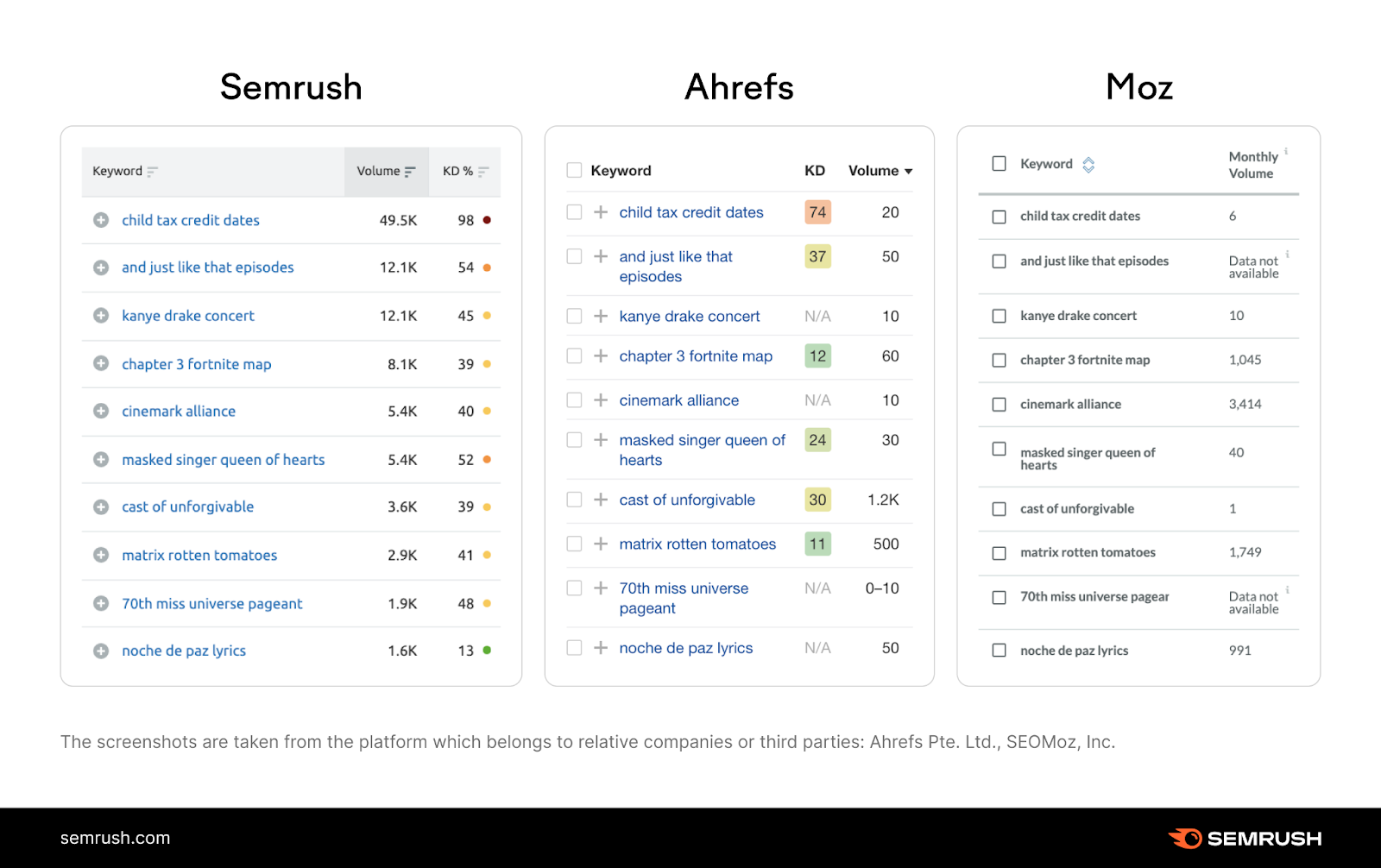
While these platforms might have certain trending terms in their database, their search volume was not close to our benchmark true value.
We think accuracy among trending keywords is another great indicator of a database’s relevancy, showing you how up-to-date the database is in general.
Not only that, but targeting trending keywords could be huge for your SEO, so you’ll need to have accurate data to capitalize.
Part 2. Database Coverage
Secondly, we wanted to estimate keyword coverage for each tool. To do this, we checked which tools had the lowest number of “not found” keywords in their database, from the sample of 10,000.
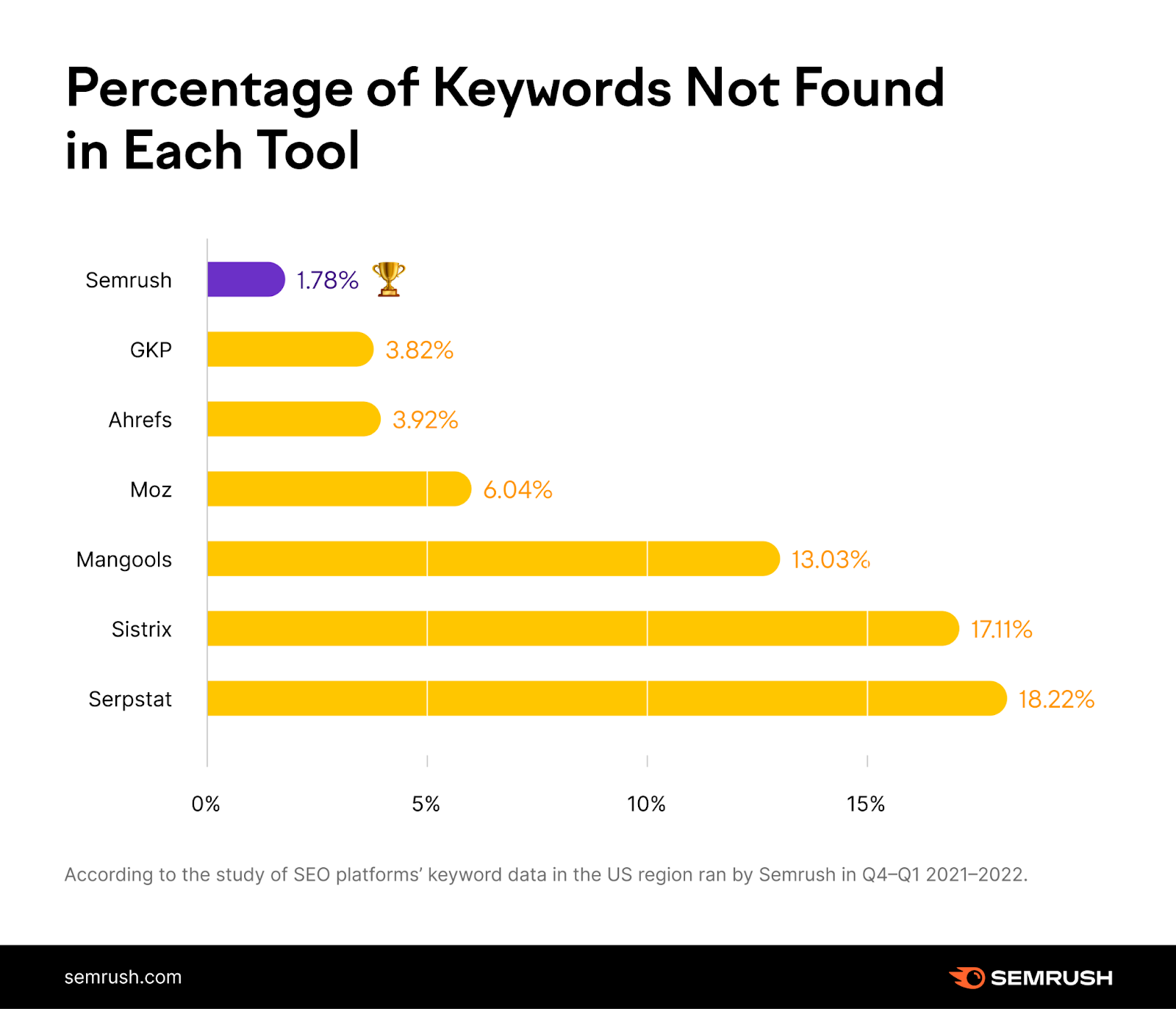
Again, in terms of coverage, Semrush’s keyword database won by a solid margin compared to other keyword tools.
What does this tell us? With the new improvements to our machine learning algorithm, you can get an accurate picture of what people are searching for in your market–for both existing keywords and new topics.
You’ll be able to find more valuable keywords in our database than anywhere else, and the search volume data will be highly accurate.
Why We Changed our Search Volume Algorithm
Right now there are a lot of options for how one could find search volume data—and SEOs don’t agree on a single source of truth.
What we aimed for and achieved was a solution that could combine all of the advantages of the keyword analysis tools already out in the market while avoiding the pitfalls.
So first, let’s talk about the most common tools and their pros and cons:
Google Keyword Planner
Google designed Google Keyword Planner to help businesses select keywords for advertising campaigns and launch their ads. However, it also has a couple of nuances to be aware of.
| Pros | Cons |
|
|
Google Search Console
You won’t find keyword volume, search volume, or anything containing the word “volume” in Google Search Console. There is a metric very close to it though—impressions. Impressions in GSC tell you exactly how many times your search result was seen on a specific keyword’s SERP.
With that being said, if your domain’s page ranks at the very top of a SERP, then 1 impression = 1 search. From that information, you can measure the exact search volume of a keyword.
| Pros | Cons |
|
|
Since it’s possible to measure a keyword’s real volume based on the top-ranking page’s number of impressions reported in GSC, we chose to use that value (impressions of the top position) as the benchmark of accurate search volume in our study. More details are found in our methodology blog post.
3rd party platforms (like Semrush, Moz, Ahrefs, and others)
Lastly, platforms like Semrush, Moz, or Ahrefs offer search volume as a metric through tools and reports to research keywords in their databases. With these tools, you can look up stats on a keyword even if your site isn’t ranking for it, and you can discover keywords that your competitor’s site is ranking for.
| Pros | Cons |
|
|
To sum it up, the cons of your current options include missing keywords, similar keywords aggregated together as one volume, and unreliable estimations from clickstream data.
We are glad to announce that thanks to our recent update, our data is even more reliable than before.
Based on our study of the top SaaS companies in the market, we found that Semrush consistently presented the most accurate search volume among industry-known SEO platforms, for both old and new keywords, large and small.
For keywords that are closely related and plural variations, we’re able to provide you with a unique and accurate volume for each query actively searched for on the internet.
For example, Google Keyword Planner will label all these terms as the same volume:
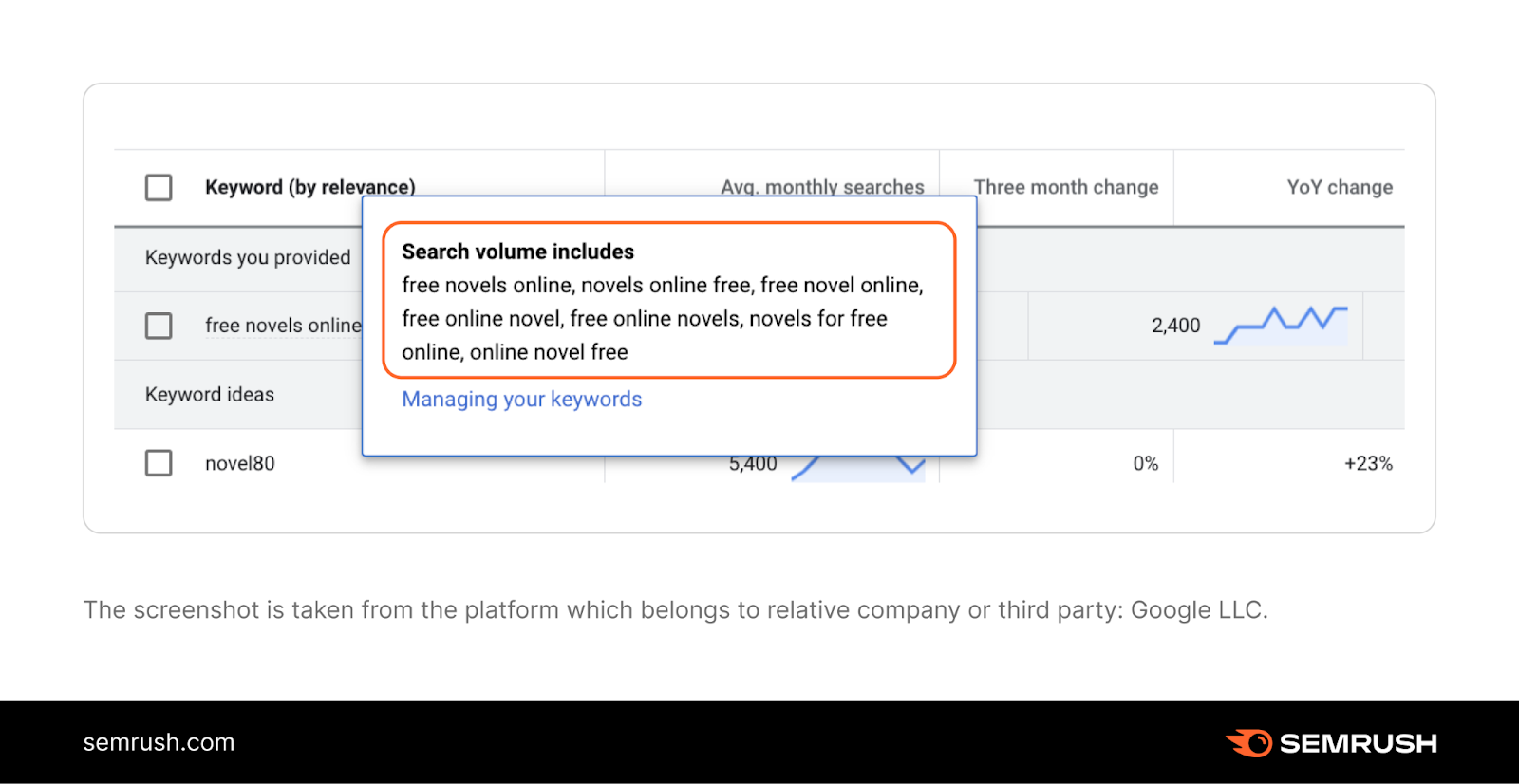
Meanwhile, Semrush can report each unique term’s unique volume:
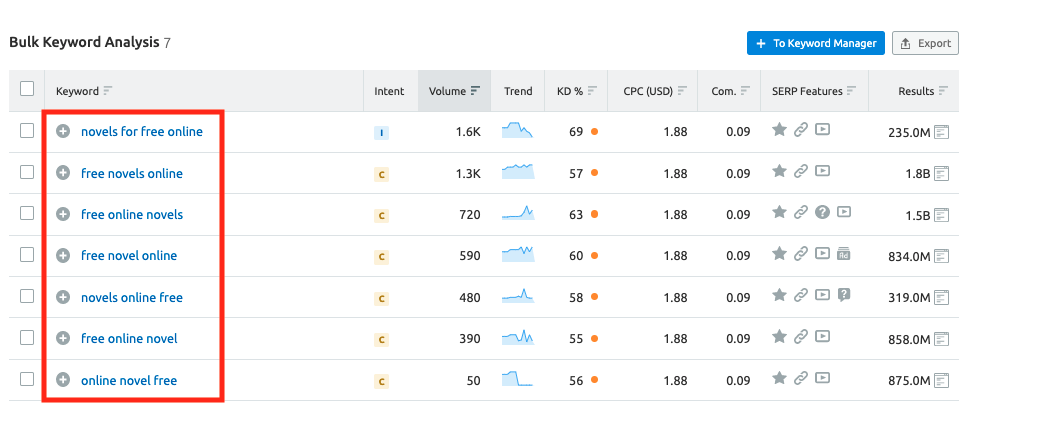
What We Changed: New Data Sources Added to the Machine Learning Algorithm
To bring together all of the strengths of what’s out there, we increased our data sources and added a few new algorithms to the mechanics.
Machine learning is like Pac-Man, the more data it consumes, the stronger it becomes. And then it reaches higher levels!
Here’s what’s new:
- Five times as many data sources as the previous algorithm
- The addition of a Natural Language Processing (NLP) algorithm that defines popularity and trends of different topics
- The addition of an Anomaly Detection algorithm that validates high-quality data from our data providers.
Now, with more data sources to work with, our algorithm identifies more patterns and ultimately performs at a higher level.
The best part of a machine learning algorithm is that it keeps learning!
Each month, the algorithm grows more relevant and understands more trends. Any unpredictable events of the past month are lessons that inform the algorithm going forward.
But, that kind of thing is a lot easier said than done!
In order to be able to process data and train the model, we spent thousands of GPU hours and tens of servers on this mission alone.
Basically, these computers were running for the equivalent of listening to the Daft Punk song “ Harder, Better, Faster, Stronger” on repeat 131,000 times.
Conclusion
Astronauts can’t land on the moon without the support of mission control.
In the same way, your marketing needs a reliable data foundation to shoot for the stars!
With this new algorithm, you can be even more confident in all of your data-driven marketing decisions.
Check out the new and improved search volume in any keyword report on Semrush, or look for “Total Volume” of a topic in the Keyword Magic Tool.
The best news is that we’re never done improving! As we continue to serve you and listen to your feedback, we’ll continue to improve our data and algorithms further and faster.
